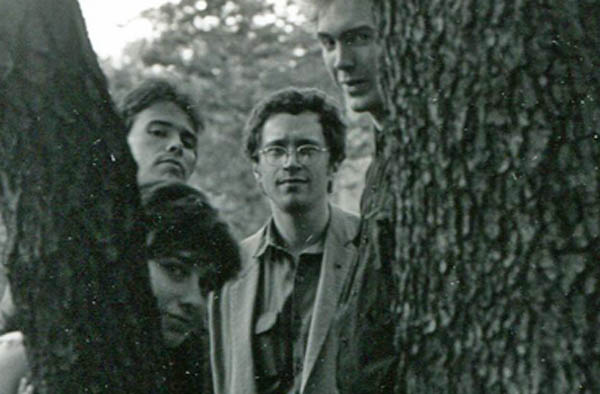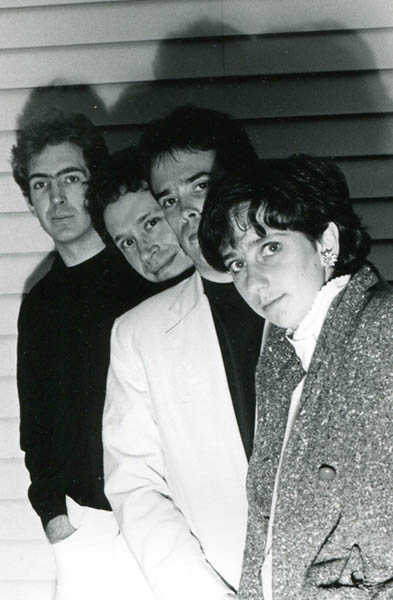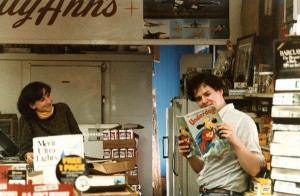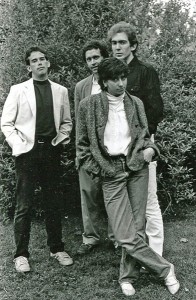Dial K for Keys: Torraca Joins the Fashion Jungle

The Kathren Torraca-era Fashion Jungle in a publicity image taken in 1984 by Gretchen Schaefer. From left: Ken Reynolds, Kathren, Doug Hubley, Steve Chapman.
“The Fashion Jungle started [the show]. For those who have still never seen this remarkable trio, I will state for the record that they are the most creative and intelligent group in Portland . . . Unfortunately, they are not at their best in cavernous confines. . . . “
“The Pathetix laid to rest all doubts I had coming in . . .On this night, they exhibited a brashness reminiscent of . . . the real Generation X. . . . The lineup has solidified at Gary Piscopo doing most of the bass playing and lead singing, guitarist Chuck Fredericks, drummer Kevin Flemming [sic] and newest addition Kathren Torraca on keyboards.”
— Seth Berner, review, “Going to A Go Go,”
Sweet Potato magazine, Nov. 10-24, 1982
Anyone involved in any way with any band will possess a vision of the band, or a version, that defines that band for them. (Rashomon much?)
To me, for example, The Beatles’ Second Album is the Fab Four’s Finest. But to the Beatles themselves it was no album at all — just Capitol Records’ sloppy housekeeping.

The most-used image of the Torraca-era Fashion Jungle, taken in 1984 by Gretchen Schaefer. From left: Steve Chapman, Doug Hubley, Ken Reynolds, Kathren.
Looking at my own bands, the version of the Fashion Jungle that may be the most definitive for the most people (probably 25 or so) began during the winter of 1982-83. Although drummer Ken Reynolds, bassist Steve Chapman and I had honed the trio format to a fine expressive edge — and we rocked pretty hard too — we wanted more instrumental color.
So when the opportunity appeared that winter to poach keyboardist Kathren Torraca from the Pathetix, we grabbed it.
It was no bolt from the blue. For years I had known the Torraca family, a smart and accomplished bunch who today are involved in demanding endeavors like restoring vintage airplanes, raising excellent families of their own and practicing emergency medicine in war zones.
I first met them at the Corner, that tendrilous social organism based at Patty Ann’s Superette, a family variety store in South Portland, Maine. They were teenagers when we met — I was a few years older — and were doing teenage stuff. Such as working after school at Patty Ann’s, making pizza and Italian sandwiches at the food counter tucked into the back of the store.
First Elizabeth Torraca and then her younger sister Kathren held that job, which resulted in a friendship that still endures between the Torracas and the family that owned the store, the Stantons — particularly Jeff Stanton, who is also one of my closest friends.
Whenever I visited the Torracas I was impressed by the implied musicality of their family life. There was a grand piano in the living room and guitars lying around, songbooks, a tambourine, a concertina. It was the most musical living room I’d ever seen, in terms of both equipment and mood. The furniture was ample and cushiony, and a curtain of trees across the house front kept the room quite dark. (The first people to hear my song “Shortwave Radio” were Jeff and Liz. I played it for them on a Torraca classical guitar.)
I formed an early impression of Kathren from a movie that Jeff made using a Kodak consumer-grade camera that miraculously captured sound as well as image. In The Corner Movie, she wears black nail polish and plays Joni Mitchell’s “River” from a songbook on the grand piano. (Aimee Torraca is another featured performer, also with a Mitchell selection. Other Corner denizens appeared as well; I’m shown in the store performing “You Know How It Is,” a song about working in a store.)
But Kathren was very young in the film and I didn’t think of her as a potential musical colleague until 1982. Enjoying a steep and fast upward trajectory that fall, the three-member FJ was somehow engaged to play the “Going to A Go Go” gig described in Seth Berner’s review excerpted above. We opened the bill for the Pathetix, the Substance and the Neighborhoods, considered one of Boston’s best alt-rock outfits. The venue was the Portland Expo; in memory it seems as big as George Miller’s Thunderdome, but much more reverberant.
The one song I can remember the Pathetix playing was John Cale’s “Dead or Alive.” But we were impressed with Kathren. I’m not sure if “poach” is the right word to describe our asking her to join the FJ; I don’t recall any particular resentment from Gary’s band thereafter — but she was rehearsing with us by February 1983, and made her FJ debut in March or April.
Musically and personally, Kathren transformed the Fashion Jungle. Kathren was, and is, very fun. (I almost called this post “A buck three-eighty,” in honor of her default price estimate for anything whose price she didn’t know; she’s big on puns and malapropisms.)
Steve, Ken and I liked to make jokes and laugh at them in that manly way that’s so much about distinguishing yourself against the world, since they’ve taken dueling away from us. But for Kat, as wry as she could be, humor seemed less about making some kind of statement and more about the sheer enjoyment of life. She was effervescent in a way the other three of us just couldn’t muster.
Her musical contribution was transformative. She played the old Farfisa rock organ that we had acquired during the Mirrors days, but the Farfisa ended up serving mostly as a stand for her main axe, a Casio keyboard that I never got close to. I never understood how she got so many colors and textures, many of them quite mind-bending, from that fairly simple rig.
Steve and I suggested parts to Kathren, but her musical sensibility was sui generis. It was painterly, often expressed in big washes of sound that billowed nicely around the hard-focused sound made by the boys of the FJ. And like Kathren herself, it was exuberant.
At the same time, Steve and I were entering our most prolific songwriting period — bringing to our work, without even trying, a sense of high mystery and romance. The tumblers clicked into place and the massive door began to swing open again. As it turned out, Portland was ready for us.
The first and last of these recordings were made during an April 1, 1983, concert at the building at the corner of Market and Middle streets in Portland — once the Rathskellar (the Mirrors played there), then Ruby Begonia’s (I played there), much later the Big Easy (the Cowlix played there).
But when the Fashion Jungle appeared in our second public performance with Kathren, it was called It’s Magic. Also on the bill were (I think) the Neighborhoods — or was it Lou Miami & The Kozmetix? Kat, who had debuted with us at Kayo’s the previous month, had absorbed part of the repertoire at that point. The mix comes off the soundboard and is quite good aside from a strange phasing sound (I’m still trying to find an effects pedal that will make that sound) and occasional swellings in the guitar signal.
The middle five songs date from September 1983. Ken Reynolds is absent from these recordings, having broken his thumb in a softball game. Using Steve’s Yamaha drum machine, we used the opportunity to record much of our current material to document the keyboard parts for the next keyboardist — as Kathren had indicated her intention to leave the band. A false alarm, as it turned out.
Personnel: Steve Chapman, bass; Doug Hubley, guitar; Ken Reynolds, drums; Kathren Torraca, keyboards. Vocals as noted.
- Censorship (Sullivan) We could do plenty as a trio, but Jim Sullivan’s protest against right-wing threats against free speech really needed a lead instrument. It was one of the first numbers Kathren learned. I sing it.
- Sporting Life (Chapman) Steve apparently imprinted on James Bond at an early age, as evidenced by this evocation of Jet Set living, as well as by “Dial M for Mamba,” below. One of his early contributions to the FJ repertoire, “Sporting Life” started as a fast rocker and later became a slow ska number. Steve sings.
- A Certain Hunger (Chapman) I liked everything Steve wrote for the FJ, but when he brought this in, I was flabbergasted by its sophistication and appeal. It’s a psychological, if not literal, portrait of someone who understands only too late that his lover is some kind of vampire. Not, as it turns out, that he minds. Steve is the singer.
- Old Masters (Chapman) The last post featured a version of Steve’s second songwriting contribution to the FJ in which he laid a new (as in 2012) vocal on a 30-year-old track by the trio FJ. Here’s a version with Kathren and the drum box. Again, a Chapman lead vocal.
- Dial M for Mamba (Chapman) A ’60s spy fantasy from Steve. I remember confusion all around about the difference between the snake and the dance, but if your life is threatened, I guess a poisonous snake is more useful than a Latin beat. But we have the beat anyway, thanks to the drum machine. Don’t ask me where I got that accent . . .
- Pleasures of the Flesh (Reynolds-Hubley) Ken and I wrote two songs together, this and “Entertainer.” In both cases, I wrote the music and he wrote the lyrics, which I edited. He also sang lead — but not on this recording, where my scratch vocal one or twice tries to conjure up some Reynoldish qualities.
- Sporting Life (Chapman) It’s back to the April Fool’s date — and the pre-Kathren portion of the set, to boot — for yet another version, crackling with musical energy and some sort of weird electronic phasing, of Steve’s song.
- Little Cries (Hubley) This was the first number I wrote for the FJ — one marked by vitriolic lyrics about bedroom dishonesty and by insanely complicated chords. Both characteristics now seem more clever than meaningful, but “Little Cries” is another entry from the original FJ that stayed with the band throughout its eight years. It was exciting onstage, where the brittle lyrics got some protective cover from decibels and Ken Reynolds’ hot-yet-precise drumming kept hearts and hormones pumping.
“Censorship” copyright © 1981 by James Sullivan. “Little Cries” copyright © 1981 by Douglas L. Hubley. “Sporting Life,” “Dial M for Mamba” and “A Certain Hunger” all copyright © 1983 by Steven Chapman. “Pleasures of the Flesh” copyright © 1983 by Kenneth W. Reynolds and Douglas L. Hubley. All rights reserved.
Text copyright © 2012 by Douglas L. Hubley. All rights reserved.

